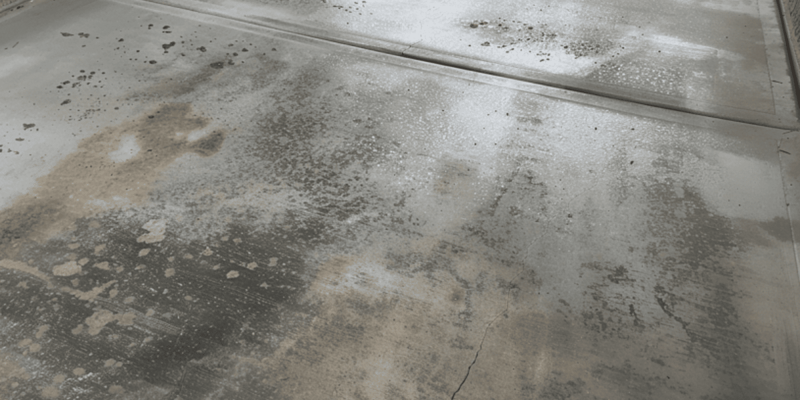Hello, Springfield homeowners! Ever noticed your shiny new concrete turning a different color than you expected? You’re not alone. Discolored concrete is a common issue that puzzles many. But don’t worry, we’re here to clear up the confusion. This article will guide you through what causes concrete to change color, how to prevent it, and what to do if your driveway or patio doesn’t look the way you hoped. Let’s dive into the world of concrete together and find some solutions.
What is Discolored Concrete?
Discolored concrete happens when parts of your concrete don’t match the rest in color. It can look blotchy, have dark spots, or just not be the color you thought it would be. This doesn’t mean your concrete is bad; it just means it looks different than expected.
Common Types of Discoloration:
Understanding why these changes happen can help us figure out how to fix them or avoid them in the future.
Blotchy: Some areas are darker or lighter than others.
Uniform Change: The whole area changes to a color you didn’t expect.
Spots and Streaks: Dark or light spots and streaks appear on the surface.
Causes of Discolored Concrete
Improper Mixing and Application
If the mix of water, cement, and aggregates (like sand and gravel) isn’t just right, or if it’s applied inconsistently, you might end up with uneven colors. Think of it like baking a cake – if you don’t mix your ingredients well, your cake won’t bake evenly.
Environmental Factors
The weather plays a big role in how your concrete looks. Too much sun or not enough, or even the temperature when your concrete was poured, can affect the color. Rain can also change the surface color if it falls on the concrete before it’s fully dried.
Material Variability
Not all cements are the same color, and different batches of materials can vary too. If your contractor uses materials from different batches or different types, this can cause color differences in the finished product.
Knowing these causes helps us figure out how to avoid discolored concrete and fix it when it happens.
Solutions for Discolored Concrete
When your concrete doesn’t look the way you hoped, don’t worry. There are several ways to improve its appearance without starting from scratch.
Surface Treatments and Sealers
One of the simplest ways to fix discoloration is by applying a sealer or a surface treatment. These can help even out the color and give your concrete a fresh, new look. Think of it as putting a protective coat of paint on your concrete.
Recoloring and Resurfacing
If the color difference is really noticeable, you might consider recoloring or resurfacing your concrete. Recoloring involves applying a new color to the surface. Resurfacing means putting a new layer of concrete over the old one, which can completely change how it looks.
Professional Assessment and Intervention
Sometimes, it’s best to call in a pro. A concrete specialist can look at your concrete and suggest the best way to fix the color. They might use special treatments or techniques that aren’t available to everyone.
Remember, it’s usually possible to improve discolored concrete without having to remove and replace it. This can save you time, money, and a lot of hassle.
Maintenance and Care of Concrete Surfaces
Taking care of your concrete can help keep it looking good and prevent discoloration from happening in the first place.
Regular Cleaning Practices
Keep your concrete clean by sweeping it regularly and washing it with a hose now and then. This gets rid of dirt and leaves that can stain the surface.
Preventative Measures for Maintaining Consistent Color
Sealing your concrete can protect it from stains, moisture, and sun damage, which can all affect color. You might need to reseal your concrete every few years, depending on how much wear and tear it gets.
Importance of Sealing and Protective Coatings
Sealers and coatings not only protect your concrete from discoloration; they also make it easier to clean and maintain. They can prevent water from seeping in and causing damage, which is especially important in places with cold winters.
By taking good care of your concrete, you can keep it looking great for years to come.
Preventing Discolored Concrete
Proper Material Selection
Make sure all the materials (cement, water, sand, and gravel) are good quality and from the same batch. This helps keep the color consistent.
Correct Mixing and Application Techniques
Like baking a cake, mixing your concrete well is key. Your contractor should mix the concrete evenly and apply it in a consistent way. This helps avoid those blotchy spots or streaks.
Environmental Considerations
Picking the right day to pour your concrete is important. A cloudy day with mild temperatures is usually best. This way, the sun or rain won’t mess with the color as it dries.
Doing these things can help keep your concrete the color you want from the start.
Discolored Concrete FAQS
These questions are super common, and it’s okay to ask them. Understanding what’s going on with your concrete helps you make the best choices for your home.
Why did my concrete discolor?
Most of the time, concrete changes color because of the reasons we just talked about: the mix wasn’t perfect, the weather had a big impact, or different materials were used. It’s usually not a sign that something’s wrong with the concrete’s strength.
Is discolored concrete a sign of poor quality?
Not necessarily. Discoloration mostly affects how the concrete looks, not how strong or durable it is. Your driveway or patio can still last a long time and be in great shape, even if the color is a bit off.
Can discolored concrete be fixed or must it be replaced?
Good news! In many cases, you don’t need to replace discolored concrete. There are ways to fix or improve the color without tearing everything out and starting over. We’ll talk more about these solutions later in the article.
Conclusion
Understanding discolored concrete is key to keeping your home’s exterior looking its best. With the right knowledge, you can prevent most discoloration issues and know how to fix them if they do happen. Remember, discolored concrete is usually more about appearance than quality. With a little care and the right treatments, your concrete can look great again. If you’re ever unsure, don’t hesitate to call a professional for advice. Your home is worth it!

